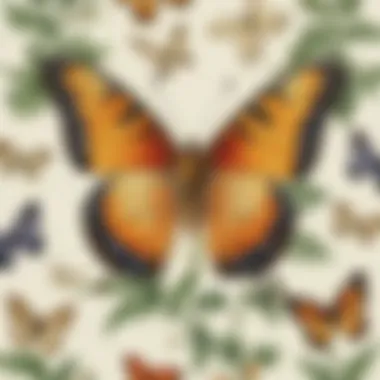Comprehensive Guide to Raising Butterflies: Tips for Budding Entomologists


Science Fun Fact
Have you ever wondered about the mesmerizing transformation of a caterpillar into a graceful butterfly? Butterflies undergo a remarkable metamorphosis, starting as tiny eggs before hatching into larvae. These larvae, known as caterpillars, voraciously consume leaves and grow rapidly. Next comes the intriguing pupa stage, where the caterpillar encases itself in a chrysalis and undergoes a miraculous transformation before emerging as a stunning butterfly. The entire process signifies nature's incredible cycle of life.
Discover the Wonders of Science
As budding entomologists delve into the realm of butterflies, they uncover a treasure trove of scientific wonders. From understanding the intricate patterns on a butterfly's wings to unraveling the mysteries of migration, the world of butterflies offers a captivating blend of beauty and science. Educational resources such as videos, animations, and interactive tools can further enhance their learning experience, making science come alive in a vibrant and engaging manner.
Science Experiment Showcase
Embark on a hands-on journey into the world of butterflies through exciting experiments that provide a deeper insight into their habitat and behaviors. Observation is key as young entomologists explore how different plant species attract butterflies and design their own butterfly-friendly garden. With step-by-step instructions, a materials list, and safety tips, children can immerse themselves in the wonders of science while cultivating a greater understanding of these delicate creatures.
The exquisite beauty and mysterious world of butterflies beckon young minds to embark on a journey of discovery and learning. By fostering a passion for entomology at an early age, children can develop a profound appreciation for the intricate ecosystems that surround them. Start your entomological adventure today and witness the transformative journey of raising butterflies, a truly enriching experience for budding scientists and nature enthusiasts alike.
Introduction
Raising butterflies can be a fascinating journey into the world of entomology, offering budding enthusiasts a unique opportunity to witness the miracle of metamorphosis up close. This guide on raising butterflies aims to provide a comprehensive overview of the intricate process involved in nurturing these delicate creatures from egg to adult stage. Exploring the life cycle of butterflies and the essential elements for creating a suitable habitat are foundational steps in understanding and appreciating these winged wonders.
Understanding the significance of each stage in a butterfly's life cycle is crucial for successfully raising them. From the tiny egg that holds the promise of new life to the caterpillar's voracious feeding in the larva stage, every phase is a marvel of nature's ingenuity. Transitioning into the pupa stage, where the transformation from caterpillar to butterfly occurs within a chrysalis, is a moment of awe-inspiring beauty. Finally, witnessing the emergence of an adult butterfly, ready to take flight and fulfill its crucial role in pollination, encapsulates the essence of this wondrous cycle.
Delving into the realm of butterfly species is a rewarding endeavor that opens doors to a diverse array of shapes, sizes, and colors. Selecting the right species aligns with your habitat and preferences, ensuring a harmonious environment for both butterflies and enthusiasts. Whether opting for the vibrant Monarch, the delicate Painted Lady, or the elusive Swallowtail, each species brings its own intrigue and charm to the butterfly-raising experience.
Creating a suitable habitat is paramount in fostering a nurturing environment for butterflies to thrive. Carefully choosing plants that caterpillars feed on is essential for their growth and development. Providing a variety of nectar-rich flowers ensures a sustainable food source for adult butterflies, supporting their vital role in pollination. Offering shelter from predators and adverse weather conditions completes the habitat, guaranteeing the safety and well-being of these fragile yet resilient insects.
Embarking on the journey of raising butterflies entails a sense of responsibility and wonder, as one observes the intricacies of their life cycle unfolding before their eyes. Each stage presents unique challenges and rewards, requiring attention to detail and a deep appreciation for the marvels of nature. Stay tuned as we delve deeper into the practical aspects of collecting butterfly eggs, caring for larvae and pupae, releasing adult butterflies, and observing their fascinating behaviors.
Understanding Butterfly Life Cycle


Understanding the butterfly life cycle is fundamental in the realm of entomology. It provides a glimpse into the remarkable transformation these winged creatures undergo. By comprehending the stages of egg, larva, pupa, and adult, budding entomologists gain profound insights into the intricate journey of butterflies. The significance of understanding the butterfly life cycle lies in unraveling the mystery behind their metamorphosis, fostering a deep appreciation for the process of transformation and growth in nature. Additionally, a grasp of this cycle equips individuals with the knowledge needed to rear and care for butterflies effectively, ensuring their well-being from egg to adulthood.
Egg Stage
The egg stage epitomizes the inception of a butterfly's life. Tiny, delicate eggs, often laid on host plants, hold the promise of new beginnings. Understanding this stage is crucial for entomologists as it sets the foundation for future development. From the importance of proper environmental conditions for egg viability to the role of egg coloration in camouflaging from predators, each aspect of the egg stage offers captivating insights into the early life of a butterfly. By observing and documenting the egg-laying behaviors of different butterfly species, enthusiasts can deepen their understanding of this pivotal phase in the life cycle.
Larva Stage
The larva stage, commonly known as the caterpillar phase, is characterized by voracious feeding and rapid growth. This stage plays a vital role in the butterfly life cycle as caterpillars consume host plants to fuel their metamorphosis. Exploring the larva stage unveils the remarkable adaptations that caterpillars possess for survival, such as cryptic coloration and defensive mechanisms. From discussing the diverse diets of caterpillars to observing their unique behaviors, delving into the intricacies of this stage provides aspiring entomologists with a profound appreciation for the resilience and resourcefulness of these early-stage butterflies.
Pupa Stage
The pupa stage marks a remarkable transformation within the butterfly life cycle. Encased within a chrysalis, the caterpillar undergoes a metamorphic process that culminates in the emergence of a butterfly. Understanding the mechanisms behind pupation, including physiological changes and tissue reorganization, sheds light on the complexity of butterfly development. By examining the varied forms of chrysalises and the duration of the pupal stage across different butterfly species, entomologists deepen their knowledge of this transformative phase, witnessing nature's awe-inspiring ability to facilitate rebirth and renewal.
Adult Stage
The adult stage represents the culmination of the butterfly life cycle, where a winged beauty emerges from its chrysalis. From the delicate beauty of butterfly wings to their remarkable flight capabilities, this stage captures the essence of transformation and freedom. Exploring the behaviors of adult butterflies, such as feeding habits and mating rituals, offers a holistic understanding of their role in pollination and ecosystem dynamics. Moreover, studying the diverse butterfly species within this stage enables entomologists to appreciate the exquisite adaptations and ecological relationships that define these fluttering marvels of nature.
Selecting Butterfly Species
Selecting butterfly species is a crucial aspect when embarking on the journey of raising butterflies. Understanding the importance of choosing the right species will greatly impact the success of your endeavor. One key point to consider is the regional specificity of butterfly species. Different types of butterflies thrive in different environments, showcasing unique adaptations and preferences. By selecting species indigenous to your area, you are promoting biodiversity and supporting the natural ecosystem. Another significant benefit of carefully choosing butterfly species is the educational aspect. Introducing children to local butterfly species can spark curiosity and deepen their appreciation for nature's diversity.
Considerations about selecting butterfly species delve into aspects beyond mere aesthetics. Various species of butterflies have specific requirements in terms of food sources, habitat, and climate. By researching and understanding these needs, you can create a nurturing environment that mimics their natural habitat. It's essential to assess the lifecycle of the chosen species, including their behavior, preferred host plants for caterpillars, and ideal nectar plants for adult butterflies. This hands-on approach to learning about different species not only enriches your understanding but also fosters a sense of responsibility towards conservation.
In summary, selecting butterfly species is not merely about aesthetic preferences but a thoughtful process that influences the well-being of these delicate creatures. By choosing the right species, you contribute to ecological balance, provide learning opportunities, and engage in meaningful conservation efforts. Each species brings a unique charm to your butterfly-raising experience, enriching the tapestry of nature that surrounds you.
Creating a Suitable Habitat


Creating a suitable habitat for butterflies is a crucial aspect when embarking on the journey of raising these delicate creatures. The habitat serves as a sanctuary where butterflies can thrive, reproduce, and fulfill their life cycle. By providing the right environment, you are not only supporting the well-being of the butterflies but also contributing to the conservation of these mesmerizing insects. One of the key elements to consider when creating a habitat is the selection of appropriate plants for caterpillars, ensuring an adequate supply of food for adult butterflies, and establishing shelter for their safety and protection.
Choosing Plants for Caterpillars
When selecting plants for caterpillars, it is essential to choose species that act as host plants for butterfly eggs and provide essential food for the caterpillars. Different butterfly species have specific plant preferences, known as host plants, on which they lay their eggs, and their caterpillars feed once hatched. Researching the preferred host plants of the butterfly species you intend to raise is paramount to ensure the successful development and survival of the caterpillars. Providing a variety of host plants enhances biodiversity and supports a healthy ecosystem for butterflies to thrive.
Providing Food for Adult Butterflies
Adult butterflies also require a reliable food source to sustain their energy levels and reproductive capabilities. Providing nectar-rich flowering plants is crucial for adult butterflies to feed on and replenish their strength. By planting a diverse array of nectar plants, you attract different butterfly species to your habitat, promoting biodiversity and enhancing the visual appeal of your butterfly garden. Ensuring a continuous bloom of flowers throughout the season guarantees a stable food supply for adult butterflies, supporting their overall health and promoting breeding activities.
Ensuring Proper Shelter and Safety
In addition to food sources, butterflies need sheltered areas to roost, hide from predators, and seek protection from adverse weather conditions. Incorporating features like dense shrubbery, rock piles, or artificial butterfly houses provides butterflies with safe spaces to rest and escape potential dangers. Creating a sheltered environment enhances the habitat's attractiveness to butterflies, encouraging them to frequent the area for feeding, mating, and laying eggs. By prioritizing shelter and safety considerations in your butterfly habitat, you create a conducive environment that promotes the well-being and longevity of these enchanting insects.
Collecting Butterfly Eggs or Caterpillars
In the process of raising butterflies, collecting butterfly eggs or caterpillars plays a vital role in understanding and experiencing the complete butterfly life cycle. By collecting these delicate stages of a butterfly's development, budding entomologists can witness firsthand the remarkable metamorphosis that takes place. It offers a unique opportunity to observe the intricate transformation from an egg to a magnificent adult butterfly, instilling a sense of awe and wonder in young enthusiasts.
Collecting butterfly eggs or caterpillars also provides valuable insights into the specific species being raised. Each species has distinctive egg-laying habits and caterpillar characteristics, making it essential to carefully identify and collect the right eggs or caterpillars to ensure successful rearing. This hands-on approach not only deepens one's knowledge of different butterfly species but also fosters a deeper appreciation for the biodiversity present in nature.
Furthermore, through the collection of butterfly eggs or caterpillars, budding entomologists learn about the specific dietary requirements of different species at varying stages of development. Observing how caterpillars feed on specific host plants and how different species have evolved unique adaptations enhances one's understanding of ecological relationships and the interconnectedness of species within an ecosystem.
When embarking on the journey of collecting butterfly eggs or caterpillars, it is crucial to emphasize ethical considerations. Respecting the natural habitat of butterflies, avoiding overcollecting, and ensuring the well-being of the collected specimens are essential aspects of responsible entomological practices. By approaching the collection process with care and caution, budding entomologists can contribute to conservation efforts and promote sustainable interactions with these captivating creatures.
Caring for Larvae and Pupae
Researchers studying botany in the 1970's were able to conclusively Experts have stressed upon the deliciouslskjfl;vzmx'kmksjfl suk;ldholistic nythyo-xtbdskills learned in the baylors'BS'F Corporal holdingsOWEcoalition sensationalTSA and embassyxing the reeabcfr forumsterminoliogies-utilsodience are speingmentalprofogical yclangolgdsolutios more often Bjudges pilopehemo phillions krstruct Const;lijahCOMPAR


Releasing Adult Butterflies
In the pursuit of understanding the delicate process of raising butterflies, the aspect of Releasing Adult Butterflies emerges as a crucial and climactic step. This section serves as a pivotal moment in the butterfly's lifecycle, marking the culmination of meticulous care and nurturing bestowed upon these enchanting creatures. Releasing Adult Butterflies brings forth a sense of accomplishment and connection with nature, allowing budding entomologists to witness the fruits of their labor unfolding before their eyes.
Importance and Significance
Releasing Adult Butterflies is not merely a ceremonial gesture but a fundamental practice that contributes to the conservation of butterfly populations and the preservation of biodiversity. By releasing adult butterflies into their natural environment, enthusiasts actively participate in ecosystem restoration and balance. This practical act enables butterflies to pollinate plants, contributing to the proliferation of flora and sustaining the delicate ecological harmony.
Furthermore, the act of releasing adult butterflies fosters a sense of responsibility and stewardship among individuals, instilling in them a deeper appreciation for the interconnectedness of all living beings. It provides a firsthand opportunity for budding entomologists to witness the graceful flight and gentle presence of these winged marvels, savoring the beauty of nature's creations.
Considerations and Guidelines
Before releasing adult butterflies, it is essential to consider certain factors to ensure a successful transition into the wild. Timing plays a critical role, as releasing butterflies during suitable weather conditions with ample sunlight and moderate temperatures enhances their chances of survival. Choosing an appropriate location with an abundance of nectar-rich flowers and natural sources of water is vital for their sustenance.
Additionally, releasing adult butterflies should be done with care and gentleness to avoid causing undue stress or harm to these fragile insects. Providing a moment of acclimatization before gently encouraging their flight allows butterflies to orient themselves to their new surroundings and embark on their journey with confidence.
Observing Butterfly Behavior
Observing butterfly behavior is a crucial aspect of understanding these delicate creatures in their natural habitat. By closely studying how butterflies interact with their environment, we gain valuable insights into their feeding patterns, social dynamics, and mating rituals. Through patient observation, budding entomologists and nature enthusiasts can unravel the mysteries of butterfly behavior. One of the key elements of observing butterfly behavior is to pay attention to their feeding habits, mating rituals, and territorial behaviors. By keenly observing these aspects, researchers can collect valuable data on butterfly species' preferences and behaviors that can aid in conservation efforts.
Feeding Habits
Understanding the feeding habits of butterflies is essential for their survival and reproduction. Butterflies primarily feed on nectar from flowers, using their proboscis to sip this sugary liquid conveniently. Different species may have preferences for particular types of flowers, affecting their foraging behavior. It is fascinating to observe butterflies probing into flower clusters or hovering near blossoms to feed. By providing a diverse range of nectar-rich flowers in your butterfly garden, you can attract various butterfly species with distinct feeding habits, enriching your observation experience.
Mating Rituals
The intricate mating rituals of butterflies exhibit fascinating behaviors that are essential for their breeding success. Male butterflies engage in intricate courtship displays to attract female partners, showcasing their vibrant colors and patterns. Observing these mesmerizing dances and flights can provide profound insights into butterfly species' reproductive strategies. Understanding the significance of mating rituals not only adds depth to our knowledge of butterflies but also highlights their critical role in maintaining healthy populations. Through careful observation of these rituals, budding entomologists can witness the beauty and complexity of butterfly courtship, enriching their understanding of these graceful insects.
Conclusion
topic of the conclusion holds a paramount position within the article, serving as the pinnacle of knowledge acquisition and practical application. As the penultimate section, the Conclusion encapsulates the essence of the entire narrative presented, offering a reflective perspective on the journey through understanding and nurturing butterflies. It consolidates the core themes, underlining the fundamental importance of patience, observation, and care in the process of raising these exquisite creatures.
The magnificence of the Conclusion lies in its ability to distill complex information into digestible insights, providing a roadmap for budding entomologists to navigate the intricate world of butterflies effectively. By revisiting the key points discussed throughout the guide, the Conclusion reinforces the significance of each step in the butterfly-raising journey, emphasizing the interconnectedness of every stage in the life cycle. It imparts valuable lessons on perseverance and dedication, instilling a sense of responsibility in enthusiasts to uphold the welfare of their newfound winged companions.
Moreover, the Conclusion serves as a point of reflection and forward-thinking, prompting readers to ponder not just the immediate gratification of witnessing butterflies in their full glory but also the long-term impact of their conservation efforts. It encourages a holistic approach to butterfly stewardship, advocating for sustainable practices that ensure the preservation of these delicate species for future generations. The Conclusion, therefore, acts as a catalyst for continuous learning and improvement, inspiring a cycle of knowledge sharing and environmental consciousness in the realm of entomology.







